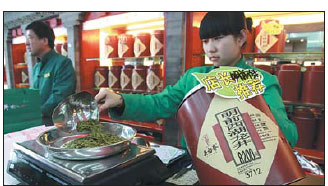The beauty of China's spring teas
For those who wish to drink the best teas of China, major Beijing tea businesses are teaming up to offer a taste of their spring teas.
The 12th Beijing Spring Tea Festival opened at the Beijing Grand View Garden on Friday and will last through Saturday. Tea companies such as Lao She Teahouse, Wuyutai and Zhangyiyuan tea stores are showcasing their spring tea products and giving free gifts or store discounts until the end of May.
The Chinese value the first batch of spring teas, especially those produced before Tomb Sweeping Day, which fell on April 4, and guyu, the last solar term in spring that fell on Tuesday. The teas, named mingqian cha and yuqian cha, are picked before these two days and are widely considered the best of the year. The spring's lower temperatures help the tea leaves maintain a higher level of fragrance.
Green tea has been shown to lower blood pressure and cholesterol, aid in digestion and help tea drinkers lose weight. It is rich in polyphenols, which are natural chemical compounds found in tea, and is believed to help reduce the risk of coronary heart disease. Some say drinking tea can help prevent cancer and corner radiation.
Spring tea is high in amino acids and vitamins, which not only imparts a better taste, but also many health benefits.
According to Chinese medical theories, the vitality of tea sprouts during the spring will help the body adapt to the rising levels of yang energy in nature.
China has many tea-producing regions, from Hainan province in the south, Shandong province in the east, to the Tibet autonomous region in the west. Spring tea leaves are the highest grade for green tea production.
For first-timers, early spring teas taste light. But if the tea is prepared with the right type of water and with the proper method, it presents a subtler structure of flavors.
Earlier this month, before Tomb Sweeping Day, I stayed briefly at a tea farmer's house in an ancient village on Dongting Mountain in Suzhou that is the original production area for biluochun. My host and hostess were tea farmers with more than 40 years of tea-making experience.
I watched the hostess screen the tea while the host roasted it in a large iron wok.
A few minutes after roasting, a delightful aroma filled the kitchen, as if we were in a garden of blooming flowers. After half an hour of continuous roasting, shaking and rubbing of the leaves, the biluochun, adorned with tender white fluff on the tiny center sprouts and a curly leaf, were ready.
The taste and fragrance are so fruity and refreshing that you wonder what chemicals constitute the beautiful sprout and what the tea shrubs have absorbed from the soil to be able to present such a bouquet. The pleasant aroma, and a sweet aftertaste, stay long in the mouth after drinking. It reminds you of the beauty of spring.
A typical biluochun tea leaf has one sprout and one tender leaf. My hostess spends two hours picking spring sprouts in the morning, another two picking out any undesirable leaf. The host then spends half an hour roasting it.
To guarantee quality, tea farmers harvest biluochun only in the spring and early summer for less than a month, commonly from March 20 to April 15. After the harvest, the farmers prune the tea shrubs, leaving them to grow for the rest of the year.
The tea shrubs are grown in between a variety of fruit trees and nut trees, such as loquat, waxberry and chestnut, which might contribute to their fruity flavor.
It is said that 60,000 to 80,000 sprouts are used to produce 500 grams of early spring biluochun, which explains its high prices.
Another famous green tea, longjing, presents a mouthful of orchid and chestnut-like aromas in the mouth after you drink it as well as a sweet aftertaste. The flavor of the green teas usually lasts for three brews.
To brew such tender tea one has to use mineral water, or well water. Tap water is likely going to ruin the subtle taste. The water temperature needs to be lowered to 80 C. If the water is too hot, the taste can become bitter.
Contact the writer at yejun@chinadaily.com.cn
For authentic spring tea, contact Ma Yi at 136-0125-3023
The author is a senior lifestyle editor with China Daily.

|
A sales clerk at a Wuyutai tea store weighs longjing green tea harvested in early spring. Provided To China Daily |
(China Daily 04/23/2016 page10)















